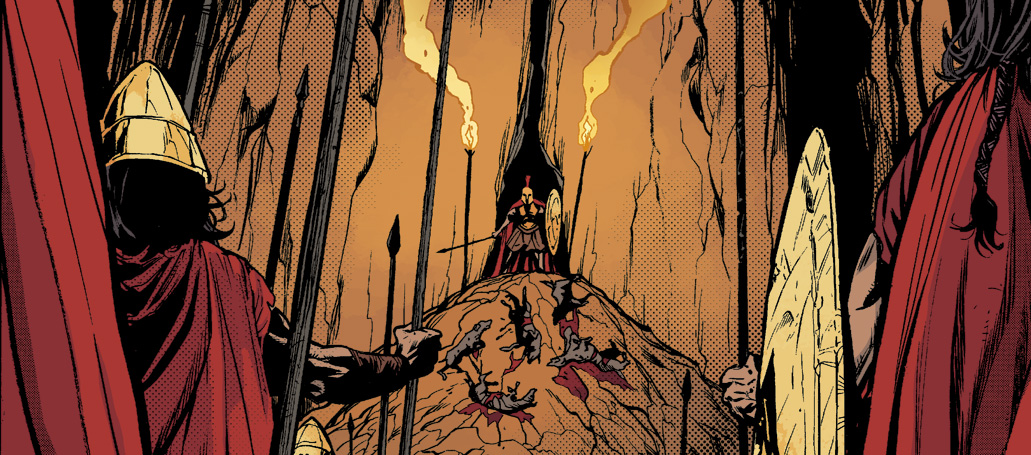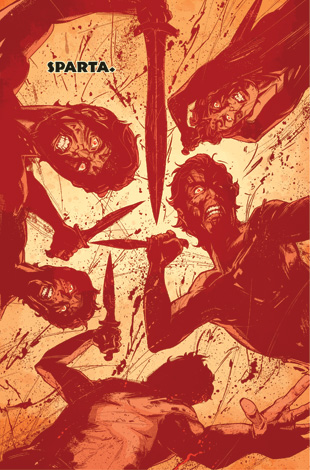
April 26, 2014, by Tara de Cozar
Comics and classics part four — dog-skin caps
Comics writer Kieron Gillen spoke at the Classical Association annual conference, held at the University at the end of April. Prof Stephen Hodkinson was the historical consultant on his recent comics series Three. I’m writing a series of posts on their roundtable discussion ‘Story telling and historical authenticity in a visual medium: the comics series Three’. The original post is here. The second one’s here and the third one’s here.
This is the final post in this series. If all this talk of statues and helmets and dog-skin caps has made you want to read the whole comic, you can buy Three and Kieron’s other books at Page 45. Other comics shops are available, they’re just nowhere near as good.
Stories explaining history
Kieron: “There’s a lot of explanatory stuff in the script where I’m saying — this is what this means, this bit we’re not so sure about, no one knows for sure. We tried to describe the environment and how people dressed, but Ryan also did his own research. There was very much a back and forth ‘what on earth does this look like?’ — discussing how people use a sword, that kind of thing. My presumption was quite often way off. Our choice of Helot dress is a good example. Eventually you get a dog cap…”
Stephen: “We have quite limited textual evidence about how Helots dressed. There is one source that talks about them being dressed in dog-skin caps, and having quite rough clothing. Because of the Spartan mirage*, we can never be quite sure of what the sources say. I put the evidence as best I could to Kieron, all on the understanding that it was his and Ryan’s prerogative to override this to suit the demands of the story. I advised trying to keep the Helot dress not elegant looking.
Kieron: “I went to Ryan and said ‘right, this is all the evidence we’ve got for clothes.’ And Ryan couldn’t see the point of a book where the three lead characters were wearing dog caps. As a visual narrative it undercuts everything. There’s a couple of characters that wear them at specific points. We worked on the cheerful assumption that they probably didn’t wear it when the Spartans weren’t around. And since Spartans weren’t around most of the time they wouldn’t be wearing it. We found a position that we could justify.”
Lynn: “You’re taking the position that the dog-skin cap is a marker that’s imposed on the Helots by the Spartans. We don’t know this, but it’s a reasonable extrapolation of the way classes are distinguished in these rigidly hierarchical societies.”
Kieron: “A lot of this came so much from Ryan. He was saying ‘I can’t make this work, this looks stupid’ and that made us as creators feel ‘if I was wearing this, it wouldn’t be because I’d chosen to’ — a gut reaction to it.”
Stephen: “And that’s one of the key themes of Three — that of Helot subversion of their own domination, in the way that recent research has shown that many oppressed peoples have quite subtle ways of going against their masters. So, not wearing the cap when there’s no Spartans around is one of those subtle, everyday forms of resistance.”
*Spartan mirage: distorted images of classical Sparta — sometimes idealising, sometimes negative — perpetrated by external supporters or critics from the rival city of Athens, and later extended by post-classical writers like Plutarch. (Thanks Stephen for the post-discussion explanation)
And to close this series of comics-heavy blogs, I’m going to post this page from issue one of Three. It’s horrific and so perfectly composed. I’ve spent ages staring at it, wondering if the Helot getting hacked to pieces marvelled at the violent choreography of his death.
No comments yet, fill out a comment to be the first



Leave a Reply